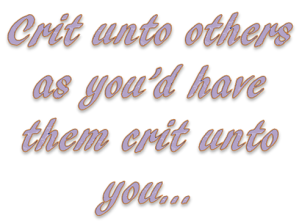Critiques are a literary “bread of life” to some
writers. Others shudder at the thought of allowing another author to
rip/tear/shred at their carefully chosen words.
To each his own.
Here’s my take on the subject. A solid critique can mean the difference in having a manuscript (which may never be seen by anyone other than the writer and the editors who reject it) or a novel (which makes the journey from writer to critique partner to writer to editor…then into print and available to readers).
I’m not here to laud the value of a critique. If
your mind is made up to hate them, I doubt I could change it anyway. So
this article is for those of you who, like me, wouldn’t dare send a
manuscript out without your critique partner—or better yet,
partners—having seen it first.
I’ll talk about giving constructive
criticism. Since I’m certainly not the reigning guru, you can take or
toss anything I say—just as I hope you would do if I critiqued your
manuscript. Because that’s the whole idea, isn’t it? Get someone else’s
take on your work. She’ll watch for typos and misspellings, sentences
that don’t flow well, and inconsistencies (like your hero having blue
eyes in one chapter and brown in another). She’ll also make suggestions
she thinks will improve your words. The thing to remember with a
critique is that, just because your crit partner makes a suggestion does
not mean you must use it. It’s a suggestion. Something to consider. That’s all.
(That’s the extent of what I’ll say about receiving a critique.)
All
that said, critiques can hurt. I’ve been there. So, while it’s
important to be honest (otherwise, what’s the point?), it’s also
important to be nice. Making the writer feel unspeakably stupid should
not be your goal.
And please, please…when you read something you do
like, say so! It’s like salve on an open wound to get that little
nugget of praise in the middle of a chapter that’s bleeding red crit
marks. It can mean the difference in leaving your critique recipient
sobbing in defeat or rejuvenated and raring to do another rewrite.
Seriously…isn’t that what it’s all about?
Let’s look at some examples. For the record, I’ve
been given permission to share these tidbits of critiques with you. (I
won’t be sharing the writers’ names or the titles of their work.) Blue text indicates my comments and/or changes.
Not wanting Nate the men to see her amusement, Rose busied herself with Jenny Ann, handing her the baby a piece of meat to chew on. Her hero acted like a she bear protecting her cubs when it came to her and the baby. (This sentence gets a little confusing, with three “hers” referring to two different “hers.”J See what I mean? With the suggested changes in that first sentence, maybe this will work:
When it came to her and Jenny, Nate behaved like a protective Mama bear with cubs.
Love the analogy, especially when referring to a supposedly big, bad he-man! lol)
Not every criticism can be followed by a compliment, but when possible…by all means, do it!
(Ever had your eyebrows or upper lip waxed? The sweet girl who does
mine follows each painful rip of skin and hair with the firm pressure of
her fingertips. It doesn’t replace the missing skin, but it sure helps
relieve the sting. I try to always remember that a critique is much like
the removal of unsightly facial hair. Each time I deliver a criticism
to some author’s literary darling, I’ve ripped away ‘skin and hair’ and
left her hurting. If I can find something to compliment, it eases the
pain. Why wouldn’t I want to do that?)
Also,
note the yellow highlights above. I use them to indicate repetition of
any word (or form of the same word) in close proximity. Without my
having to voice a single criticism, my critique partners know what they
mean: You should probably rephrase, and avoid overuse of this word.
One more example. This one is taken from a synopsis, thus the “telling, not showing” style of writing.
(When? I’d insert that here. “Two years ago, Scott…”) Scott
Lunsford experienced every firefighter’s nightmare when he answered a
routine accident call involving a loved one. No matter how hard he
tried, he couldn’t get the images of his girlfriend Julie’s shattered
body out of his mind.
Counselors recommended time off and he decided to
go someplace with happier memories. His grandmother’s turn-of-the
century-house has set been vacant since she passed away almost two years earlier. (Your call. Nothing wrong with “set,” it just sounds weird to my ears today. lol) Scott
thinks it’s the perfect time to start renovations on the old place. But
he’s not prepared for the amount of work the house needs and even less
prepared for the ghostly images of Julie that show up nightly every night!
Offering an opinion is fine, even if it isn’t
necessarily a “rule” of writing. In this case, my suggestion to replace
“set” with “been” is nothing more than personal taste. But that’s all
right…it’s like a mini-brainstorm session. The author can take it or
leave it, but it gives her something to think about.
As the one on the giving end of the critique, it’s
important to remember that you’re not there to rewrite the book. Let
that author keep her voice and style. Your task is to watch for several
things in particular, including (but certainly not limited to):
- Typos
- Misspellings
- Inconsistencies
- Incorrect grammar
- Kinks in the flow of the storyline
- Repetitive words
- Weasel words
- Timeline issues
- Anything else that seems “iffy” or makes you backtrack/re-read.
What is most helpful to you in a critique? Or do you simply shy away from them? If so…why?
Let’s talk about it…



No comments:
Post a Comment